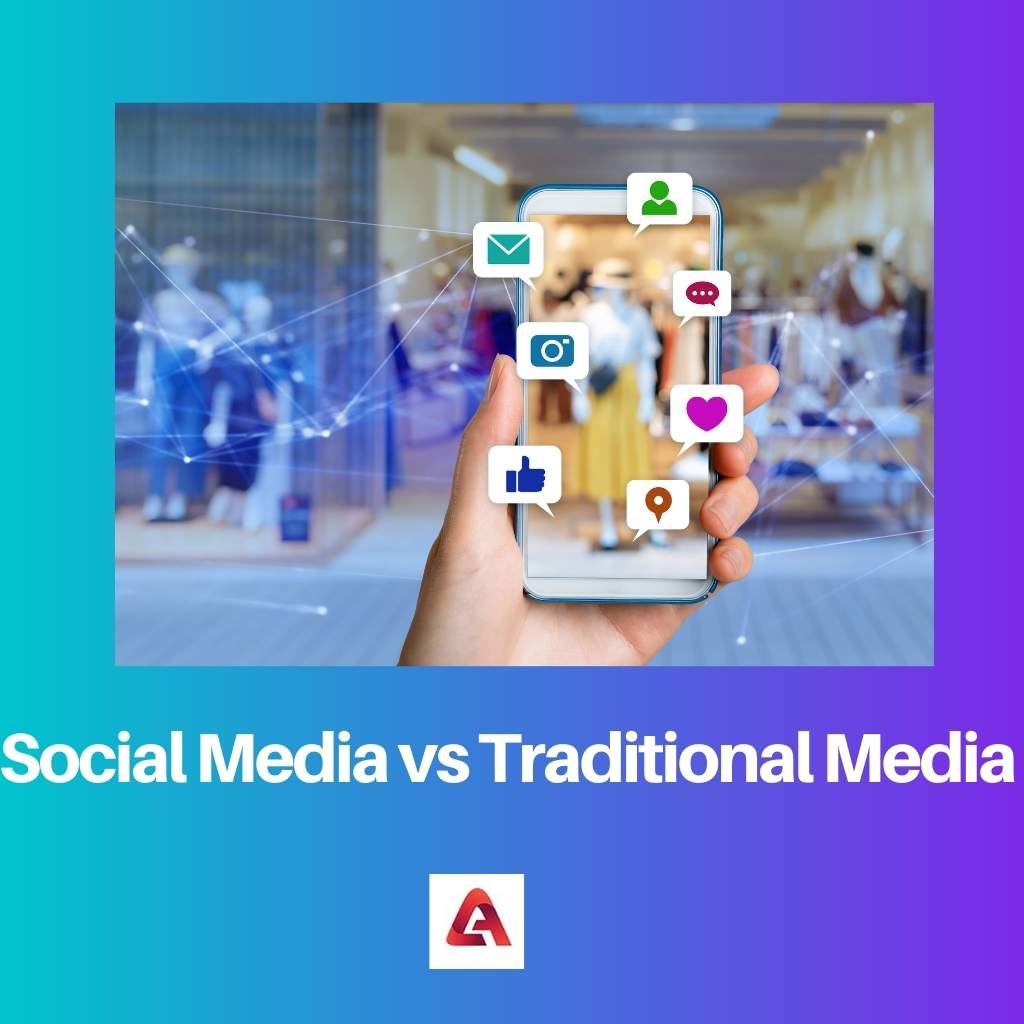In today’s world, when people are more in favour of talking to each other in messages rather than face to face. It just shows how people have changed, how this modern invention of Social Media has changed how the world is seen.
Traditional Media and Social Media follow the same concept of disposing of information and data, but their ways of fulfilling this purpose are opposite to each other. Each one has its pros and cons, and it depends from person to person on which form they are more comfortable in.
Key Takeaways
- Social media refers to online platforms that allow users to create and share content. In contrast, traditional media refers to more traditional forms of mass communication, such as television, radio, and print.
- Social media is more interactive and allows for more personalized content, while traditional media reaches a broader audience.
- Social and traditional media can be used for marketing and advertising, but they have different strengths and weaknesses.
Social Media vs Traditional Media
Social media are online platforms where users can interact with each other. People can also share different types of content on social media. Billions of people are using social media for educational, entertainment, marketing and many other purposes. Television and radio are traditional media. The content published on traditional media is irreversible.

Social Media is a place that can be used not only for news-related topics but for sharing of a person’s life, promotion of brands, and overall, people who want to stay connected indifferent of their place of the area around the world.
Traditional Media mainly consists of four main components: Television, Radio, Newspapers, and Magazines. Before the invention of social media in the 21st century, it was the main thing used to distribute information and data to people.
Comparison Table
| Parameters of Comparison | Social Media | Traditional Media |
|---|---|---|
| Another name | Social network, Social platform | Old Media |
| Reversibility | Easily reversible. The publisher can edit or delete the post. | Almost non-reversible. Once a piece of information is published or on-air, it is hard t rewind. |
| Main focus | Social Media’s main focus is to unite friends, family, and other people of the world. | Traditional Media’s main focus is to publish news and entertainment. |
| Communication system | Both the parties, that is, the publisher d the reader, can react. | In Traditional Media, only the only publisher, that is, the editors, is in charge of the information. |
| Time consumed | Almost instant and quite fast in comparison to Traditional Media. | It takes a longer period amount of time to publish information. |
| Examples | Twitter, Facebook, Instagram, etc. | Television, Radio, Newspapers, etc. |
What is Social Media?
The great thing about social media was how it gave a voice to voiceless people.” This a quote by a famous journalist Jon Ronson and it perfectly describes the use of Social Media and its need in today’s world.
Social Media can be described as a way to express information about various topics.
The concept of “posts” is used in most Social Media like Instagram or Facebook. This is the main way to share information on these Social Media networks. Other sites like YouTube do not have this feature but are around creating and posting videos.
Because of Social Media, not only an individual get informed but can communicate as well.
They can connect to friends, relatives, and families over popular Social Media sites like Facebook, Twitter, Instagram, and many more. This is the biggest advantage that Social Media has over Traditional Media.

What is Traditional Media?
Traditional Media is the oldest form of communication. The main components of it are Newspapers, Magazines, TV, and Radio. Now, it has added more forms to this network of four, including Blogs and digital newspapers that are used to keep people up to date.
Marketers and many big businesses use Traditional Media to advertise their services and products to the general public. These efforts are expensive, especially in comparison to Social Media. But they are quite useful as well.
Social Media has become habitual nowadays, and people are quite active on it.
But still, there are certain places, small villages, and islands, whether they be in a small country or a bigger one, where people do not have access to these Social Media sites. Thus, they are dependent on Traditional Media, especially Television and Newspapers, to reach for information.

Main Differences Between Social Media and Traditional Media
- The power to write and publish information on any Traditional Media form is with the editor of that particular Media. In comparison, anybody can share any information on their page on any Social Media outlet.
- The time needed to produce Social Media information is comparatively much shorter than on Traditional Media. The fastest form of Traditional Media can be newspapers and their own blogs, and it takes at least a day or a few hours to publish. While on Social Media, the data can be shared anytime.
- Social Media has the option of people performing different tasks on it, for example, liking and sharing images and other personal information, etc. On the other hand, Traditional Media do not have any of these things but only authorized information.
- People can edit or delete the post(s) sharing their information, image, or video that they have made on their account on Social Media. This is not possible during the process of publishing in Traditional Media. Once a piece of information is placed, it is impossible, and if possible, it is quite hard to change the existing information.
- Traditional Media is about reaching people out there. In comparison, An account on Social Media needs to have engagement with people. Activities like Reactions and interactions are mostly needed in Social Media.

References
- https://books.google.co.in/books?id=2iVFDwAAQBAJ&printsec=frontcover&dq=social+and+traditional+media&hl=en&sa=X&ved=2ahUKEwj71PKtzMfwAhVmqksFHQ8gARY4ChDoATAGegQIChAD#v=onepage&q=social%20and%20traditional%20media&f=false
- https://journals.sagepub.com/doi/abs/10.1177/0002716215570549

Great insights into the differences between traditional media and social media. Both have their unique advantages and disadvantages, and it’s important to understand how they impact the way information is shared and consumed.
I completely agree with you. It’s fascinating to see how social media has revolutionized the way we communicate and share information with one another.
The distinction between social media and traditional media is well-delineated. It’s crucial to acknowledge the diverse ways in which these two platforms contribute to information sharing and communication.
I couldn’t agree more. Understanding the roles of social media and traditional media is imperative for individuals and businesses alike.
Absolutely, the comprehensive analysis of social media and traditional media provides valuable insights into their functionalities and impact on modern society.
I appreciate the detailed comparison between social media and traditional media. It’s crucial to recognize the distinct features of each platform and how they serve different purposes.
Absolutely, understanding the unique strengths and weaknesses of social media and traditional media is essential for effectively utilizing both platforms.
The comprehensive overview of social media and traditional media provides valuable insights into their respective functionalities and impacts. Understanding the distinct features of both platforms is crucial for effective communication and information dissemination.
Absolutely, the article sheds light on the diverse roles of social media and traditional media, offering a deeper understanding of their significance in contemporary communication.
I couldn’t agree more. The analysis of social media and traditional media contributes to a nuanced understanding of their roles in shaping modern communication and information sharing.
The description of social media and traditional media is well-articulated. It’s interesting to see how the evolution of communication has led to the coexistence of these two forms of media.
Definitely, the integration of traditional media and social media has transformed the landscape of information dissemination and consumer engagement.
The in-depth comparison of social media and traditional media offers a comprehensive understanding of their distinct characteristics and functionalities. This article serves as a valuable resource for comprehending the role of both platforms in modern communication.
I completely agree. The detailed analysis of social media and traditional media is instrumental in understanding their influence on information sharing and audience engagement.
The detailed explanation of social media and traditional media is enlightening. It’s essential to recognize the significance of both platforms in the realm of information dissemination and connectivity.
Indeed, understanding the distinct characteristics of social media and traditional media is pivotal for navigating the digital landscape and maximizing their benefits.
The detailed comparison between social media and traditional media is enlightening. It’s crucial to recognize the unique attributes and functionalities of each platform for effective engagement and communication.
Absolutely, the nuanced analysis of social media and traditional media enhances our understanding of their roles in shaping contemporary communication and connectivity.
Indeed, the article provides a comprehensive understanding of the distinctive features of social media and traditional media, highlighting their impact on global communication and information dissemination.
This article effectively outlines the key differences between social media and traditional media. The comparison table provides a clear understanding of the unique aspects of each platform.
The article effectively presents the similarities and differences between social media and traditional media. It highlights the unique attributes of each platform and their respective roles in modern communication.
Absolutely, the comprehensive overview of social media and traditional media provides valuable insights into their functionalities and impact on information dissemination.